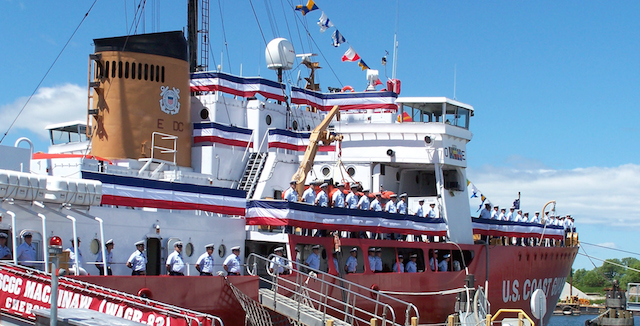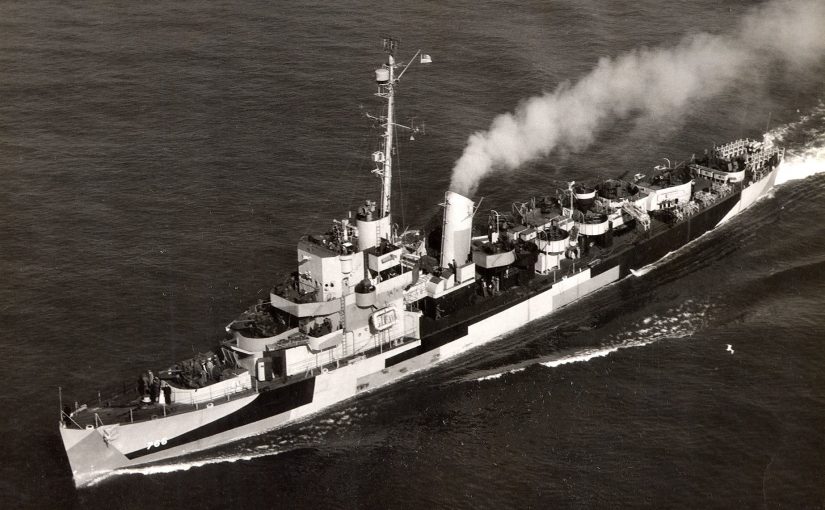Joe and Barb Traub aren’t your typical museum volunteers. They volunteer their time and sewing talents for the United States Coast Guard Cutter Mackinaw WAGB-83. This decommissioned Icebreaker ship was built during World War II as part of the war effort. While touring the ship, the couple couldn’t help noticing that some canvas covers were torn up and damaged due to the harsh winters on Lake Huron. One project led to another, and they have been sewing covers and other pieces for the ship ever since. Read about Joe and Barb, their sewing background, and a little bit of the Icebreaker’s history and the role it played in the war.
A Piece of History
The USCGC Mackinaw was built in response to the increased need to transport war materials — specifically ore — during the winter months of World War II. Icebreaker ships are designed with a strengthened hull engineered to plow through heavy ice and create a path for smaller boats to travel. Dubbed the “Queen of the Great Lakes” and “The Largest Icebreaker on the Great Lakes,” Congress authorized construction of Mackinaw on December 17, 1941, just 10 days after the bombing of Pearl Harbor.

The ship was built in Toledo, Ohio, and cost $10 million. The Toledo Shipbuilding Company won the contract. However, several delays and penalties forced the company to declare bankruptcy, and the construction was completed by the American Shipbuilding Company. The keel was laid on March 20, 1943. The ship is 290 feet long and the design is based on the Wind class of Coast Guard Icebreakers. However, Mackinaw was built wider and longer than other ships in this class so that the draft would be shallower. The hull was launched on March 4, 1944, and the ship was commissioned on December 30 of that year. Cheboygan, Michigan, remained the ship’s home port its entire life during active service.
The ship served many roles over its esteemed 62-year career. Not only was the Icebreaker a vital part of the war effort, but it also rescued stranded ships, assisted with shipwrecks, and even delivered Christmas trees to underprivileged children in Chicago. Mackinaw is a beacon of hope, a symbol of determination and goodwill not only for the Great Lakes region, but America at large.
Decommissioned in 2006, the Icebreaker now resides in its namesake port, Mackinaw City, Michigan, and serves as a floating maritime museum. The museum’s educational programming and exhibits teach visitors about maritime history and the economy and ecology of Michigan and the Great Lakes. The ship is open to the public from mid-May to mid-October every year. Aboard the ship, workers offer public tours, educational tours, overnight encampments and group events.
Sailing, Sewing & Sailrite
Barb learned to sew during her youth. Her mother was a high school home economics teacher and taught her daughter everything she knew. When they were married, Barb then taught Joe how to sew. The couple enjoys working on sewing projects together — both projects for their home life and sailing hobby, as well as the projects for the Mackinaw. “We do the projects together for the ship,” Joe said. “Barb is the guiding hand that directs the process. She is the brain, and I work at her direction as I learn.”
The Traubs are longtime Sailrite customers with a unique connection to the company. Their first sewing project as a couple was a tiller cover for their Ranger 26 sailboat. Working in Columbia City in 1989 and needing supplies, Joe happened upon a local business called Sailrite. “I purchased the materials from [founder] Jim Grant himself and have been a customer ever since.” The couple even raced with Jim Grant when they were living in Indianapolis and members of the same sailing club.

Besides sailing, they enjoy travel and home improvement projects. “We have made a variety of projects over the years,” recounted Joe. “We’ve sewn Sunbrella® window covers for our cottage and diaper bags and tote bags from old sails.” The couple have also completed a hard top dodger and bimini for their Catalina 30 sailboat, a fire pit cover and numerous sail repairs for their friends in Florida, where they’ve wintered for the past 10 years.
Sewing for the Mackinaw
Joe and Barb Traub have been involved with the Mackinaw since 2015. “Our neighbor is the director of the museum and another friend works in the office,” Joe explained. “During a visit on the ship, we noticed that some of the canvas covers were in bad shape from the continued exposure to the weather. We asked if we could make a cover for the fuel storage area. One project led to another, to another, and on and on.”

The Mackinaw received a grant in 2018 to spruce up the historic ship, including resurfacing and repainting all exterior surfaces. The project’s goal was to preserve this important piece of American history and prevent further deterioration. Joe and Barb have been busy helping with this effort by sewing covers to keep certain parts of the exterior protected and well maintained. “We are volunteers just trying to maintain the appearance of the ship,” Joe stated.
The couple has completed three projects for the ship. Their first project was the cover for a fuel storage area made from Sunbrella Marine Grade fabric. Next, they completed eight docking pedestal covers made from vinyl and eight letter bags that hang above the lifeboats. “For the letter bags, one side required stitching through four layers of 20-ounce vinyl. No problem for the Ultrafeed®! “We’re currently working on a tow line winch cover that is 60 inches wide by 12 feet in diameter. The Sunbrella, thread, fasteners and HH-66 Vinyl Cement were all ordered from Sailrite.”
Joe and Barb are proud that their covers protect exterior parts of the ship and enhance the look and appeal of the vessel. They feel honored to donate their time and talents toward volunteering for such an important and noble piece of American history. Mackinaw WAGB-83 is a continuous reminder of American ingenuity, hard work and determination. The ship serves as a goodwill ambassador throughout the Great Lakes region, educating and inspiring both the young and young at heart.

To learn more about the ship’s history and museum information, please visit www.themackinaw.org.
Who We Are
Sailrite is your one-stop DIY shop! We are a passionate crew of do-it-yourselfers who strive to equip you with the supplies and how-to knowledge you need to tackle your next project. Do you want to learn upholstery, leatherwork, canvaswork, hobby sewing, bag making or more? We have the fabric, tools, hardware, sewing machines and notions you need to master any DIY. And even if you’ve never sewn before, our tutorials and how-to videos are designed for beginners and experienced crafters alike.
Start your DIY journey today: www.sailrite.com








